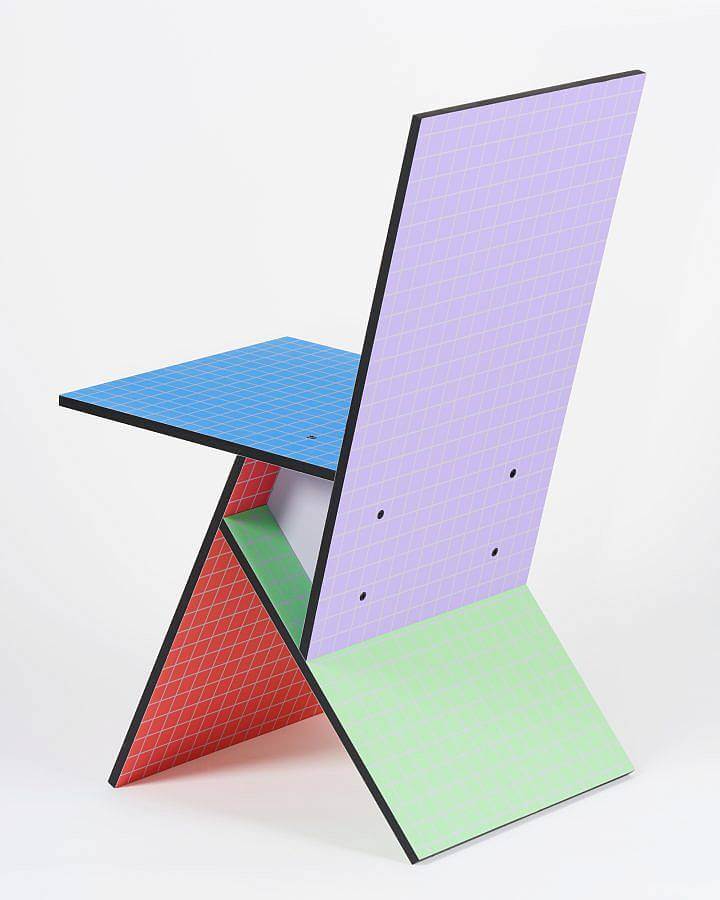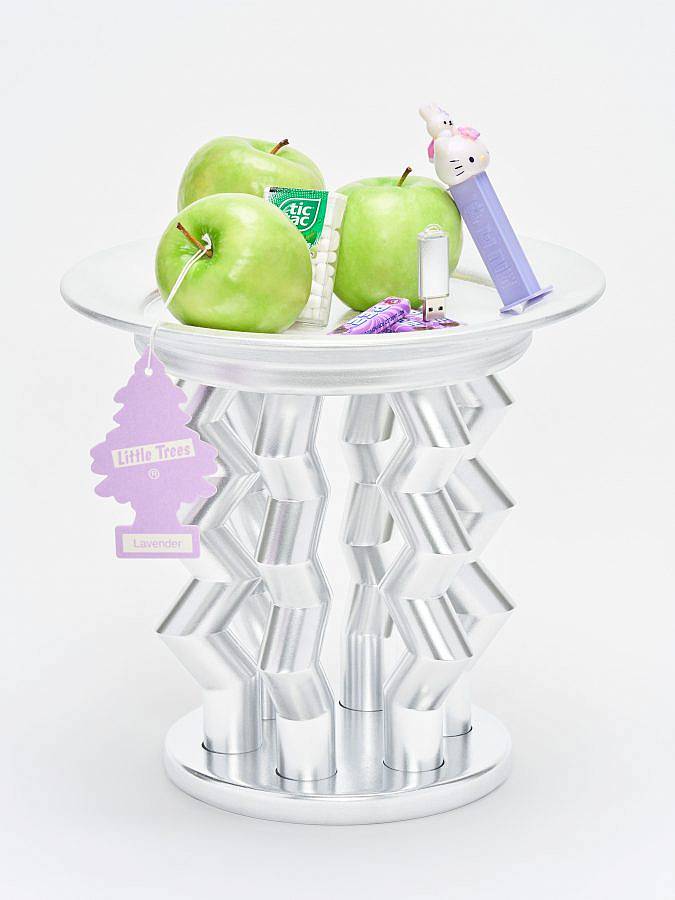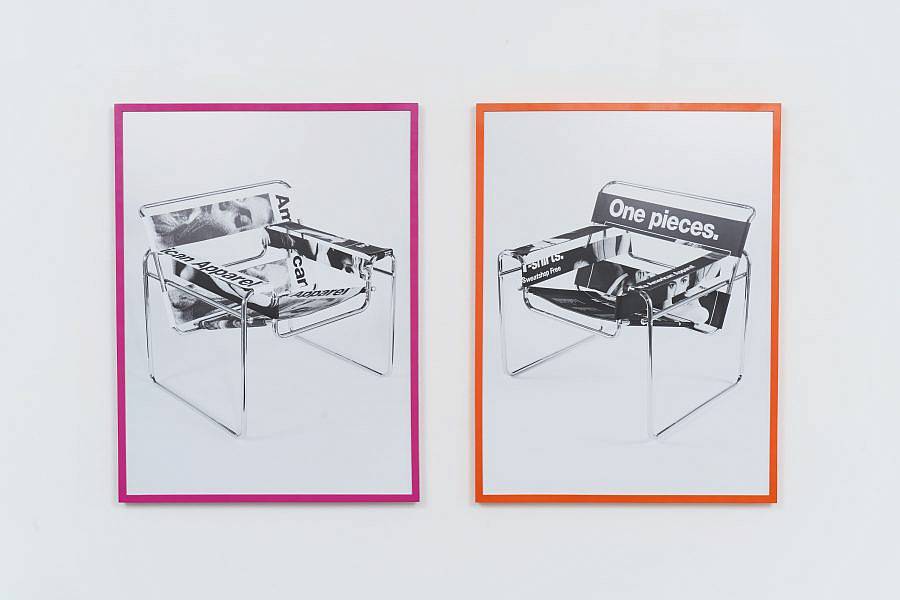Tell us a bit about yourselves and what you do.
RJ: I come from a design background but I work with a variety of media, including sculpture, photo, and video. More recently I’ve incorporated modes of manufacturing like 3D printing and CNC milling into my practice—I’m almost always working with processes that translate digital forms into physical objects
BB: I’m currently in my second year of the MFA program at University of California, Riverside. I come from a commercial image production background which informs much of my work. I’m interested in using these commercial processes as a way of analyzing the culture and media they perpetuate.
How did the two of you first meet?
RJ: We both went to undergrad in St. Louis, Brandon was running a Risograph printing workshop that I attended.
BB: A few months later we started working on projects together and I was given a free Risograph that I had no use for, which of course I gave to Rachel. After that I would always offer to come over and fix it when it inevitably had issues.

RJ: One of our first dates was going to a defunct print shop in Alton, Illinois that was selling off dead stock paper on Craigslist. It was quite the haul and we both still have a bunch of decade old paper in weird colors and sizes.
How did you get involved with “Do Not Research” and what is the origin of the group show that you were both a part of?
BB: I’ve been a fan of Joshua Citarella’s work for years, when he started the Discord sever I was quick to join but it took quite some time to begin getting involved, Rachel actually pushed me to get more involved once I introduced her to the project.
RJ: There’s a #share-your-work channel in the @do.not.research Discord where we both posted work—the @lower_cavity group show was curated around the work posted in this channel over the past year or so. I started using Discord more frequently after becoming increasingly frustrated with Instagram and other platforms. It’s one of the only spaces where the conversations we are interested in are being had.

Can you talk about your most recent duo exhibition “Network Spirituality”?
BB/RJ: Network Spirituality is a response to the cultural schizophrenia of the past 10 years. It was an opportunity to focus on building a body of work that used postmodern design as a vessel for contemporary themes and images. We are generally interested in trend analysis/prediction and hyperstition (essentially self fulfilling prophecy) and how these relate to the recent talk of a “vibe shift”. You could say our work predicted the “return” of indie sleaze or Olivia Rodrigo’s recent partnership with Glossier, but we think these occurrences were quite obvious if one was paying attention. The centerpiece of the show was a bootleg of a console table with mirror by Ettore Sottsass which held a violet American Apparel tennis skirt with facsimiles of an Olivia Rodrigo x Sour Patch Kids box and Tiqqun’s Theory Of The Young Girl with a custom violet cover. It’s all a bit conspiratorial, at this point it’s hard to believe any seemingly organic cultural phenomena is not highly constructed.
Favorite studio snack?
BB: Dunkin’s Charli DeAmelio cold brew.
RJ: I got really into drinking Bang Energy for a while but I started worrying about its longterm effects on my health so I mostly stopped. My favorite flavors are cotton candy and blue razz.

Can you talk about your use of photographs in your work? What is the conceptual consideration of the constant employment of hard, front-flash photographs throughout your bodies of work?
BB/RJ: The use of images in our work is part of a lineage of art using photography such as 60-70’s conceptual works, the pictures generation, and the post-internet movement. Both of us were too young to fully experience or be involved in post-internet art so it’s naturally the movement we are responding to in many ways. Much of our newer work is interested in the idea of de-virtualization, this entails using online information as a recipe for the creation of a physical objects, these objects are often mediated through the use of photography. The photograph allows for a much more controlled interaction with objects which is important, often times they are read as renderings which is great. In regard to the use of flash, it’s a loaded gesture, it can have multiple implications, crime scene, fashion, editorial, etc. It complicates the reading of the image and imbues it with a particular aura.
How did you begin working on Special Effects?
BB/RJ: After we left St. Louis it felt necessary to start fresh so we began a new publishing entity. Our first book, Higher Source, was a catalog of photographs we took driving around to all the infamous crime scene and cult locations in LA. Art books are incredibly important to both of us, coming from cities with small art scenes. We are generally not interested in traditional models of selling art so Special Effects has become a way to sell editions of objects.

What have you been reading lately?
BB/RJ: Understanding Media: The Extensions of Man by Marshall McLuhan, “Dispersion” by Seth Price, The Shape of Things by Villem Flusser, anything from Dean Kissick or Spike Magazine, Sean Monahan’s substack, Artie Vierkant’s “Image Objects,” Tiqqun’s Preliminary Materials For A Theory Of The Young Girl, “Reinventing the Medium” by Rosalind Krauss, The Anti-Aesthetic by Hal Foster, Oliver Laric’s “Versions”, and of course donotresearch.net.
Your works are often informed by esoteric, online spaces, many of which promote alternative information and ways of learning. How has your exposure to these sources affected your feelings toward art education?
BB/RJ: The emergence of “Theorygram/Politigram” meme pages on Instagram over the past few years has served as an entry point into texts that we would likely not encounter in academic spaces. Memes can allow for a more distilled read of often dense theory and shed a lot of the institutional pressure to hyper intellectualize relatively simple ideas. Do Not Research has been a great resource outside of traditional academic institutions. Arts education is definitely in a bit of a crisis at the moment, as the transmission of new information and theory accelerates, legacy institutions have done a poor job keeping up. So little interesting/relevant work is happening in these institutions, we will see an increasing reliance on alternative models of education unless something changes.

How would you describe your relationship(s) with digital media and contemporary internet culture?
BB/RJ: We were 13-16 when Instagram came out, for us the delineation between “culture” and “internet culture” is essentially obsolete at this point. Since the early 2010s culture has been almost entirely predicated on what happens online. Our constant self-imposed exposure to media is a form of research. One of the things that is so liberating about having an artistic practice is not having to adhere to the same research protocol as more rigid fields like anthropology or media studies. It allows us to more rapidly address cultural phenomena as it happens and to take a more expressive approach to its visualization.

Can you talk about your relationship with Design and how it affects your practice(s)?
RJ: I work a day job as a graphic designer at a branding agency, which keeps me very tapped into commercial aesthetics and patterns of visual transmission, both of which heavily inform my practice. My relationship to design is a bit fraught. I find myself struggling to extract it from its implications as a tool to promote consumption, but I also think that design has a lot of subsets and in many cases it shouldn’t be distinguished from art. For the most part, I like using design as a vessel for more conceptual ideas—I love bootlegging and infusing preexisting, often inaccessible objects with new meanings and more democratic forms. Sometimes within this mode of working I need to sit on ideas for quite some time, so it’s satisfying to supplement it with projects that require less rationalization and more prototyping. In the in-between when I’m letting ideas evolve, I find myself making domestic objects, like mirrors and lamps, with the intent of selling them as editions on the Special Effects site.
BB: In regards to graphic design, branding, advertising, etc. I think this is just the territory I am interested in discussing as it has increasingly dire implications on our lives. We are living in a moment that is full of contradictions, one of which is the aestheticization of everything through marketing while the quality of objects we interact with is perpetually being reduced. Premium mediocre/direct to consumer brands and their consequences have been a disaster for the human race. In regards to the historic design movements we reference, I don’t see as much of a distinction from art, many of my favorite works are design objects. Aesthetics have always been of upmost importance to me.
Any upcoming projects?
BB/RJ: We are planning to release several new books and objects through Special Effects over the summer.
Interview conducted and edited by Sam Dybeck.
